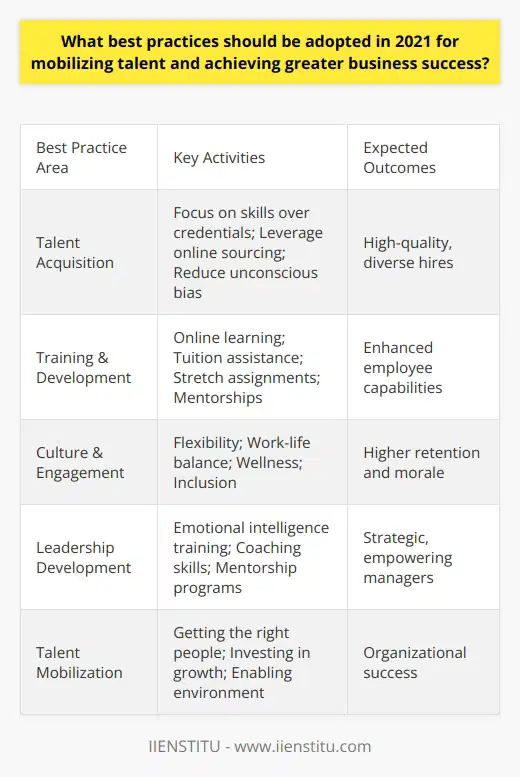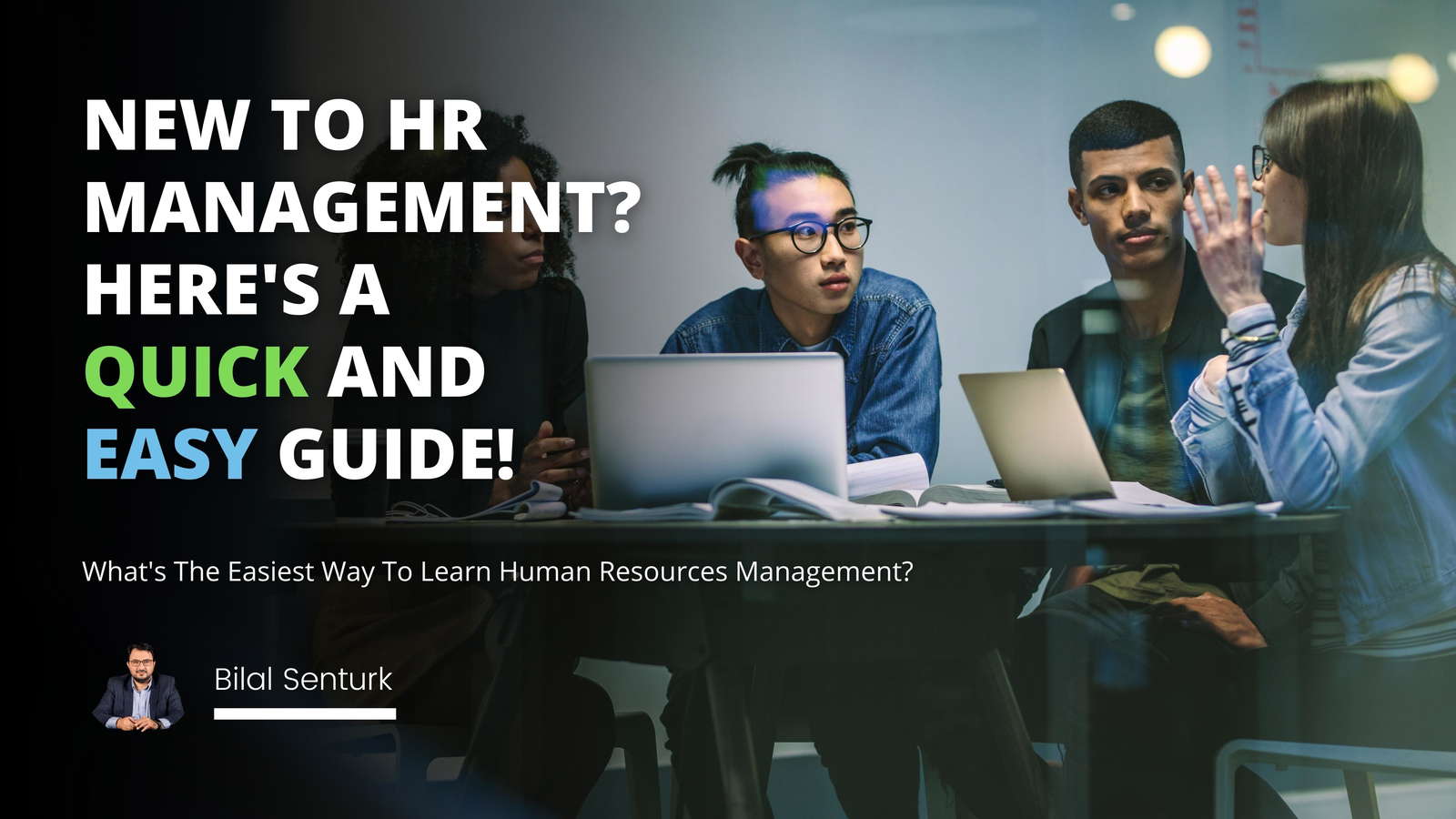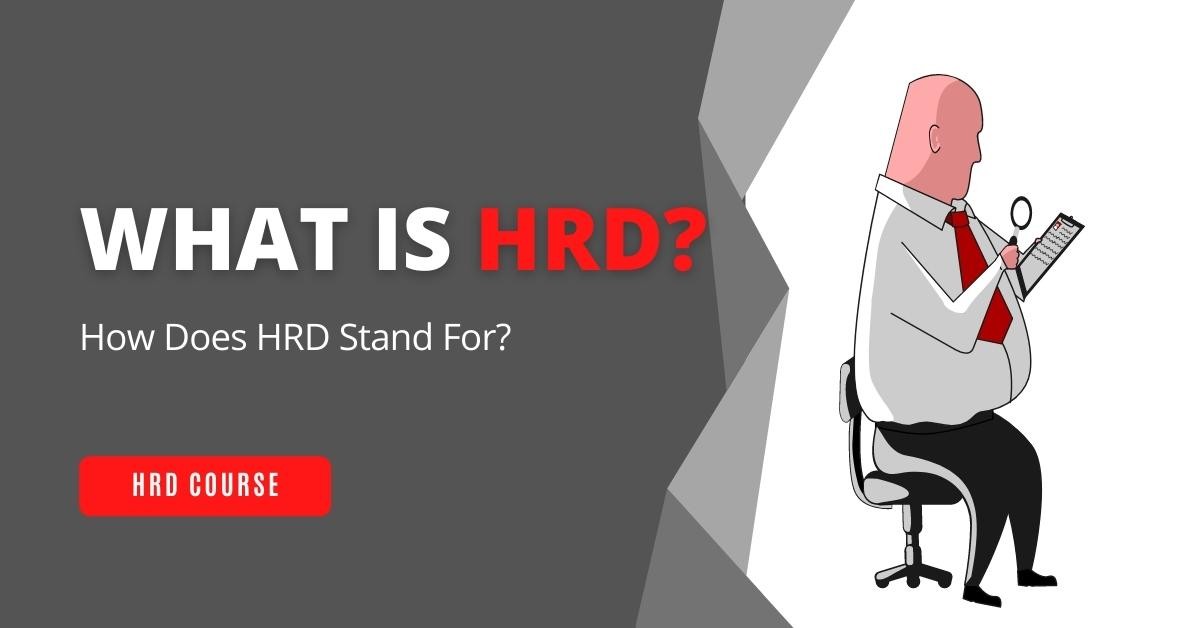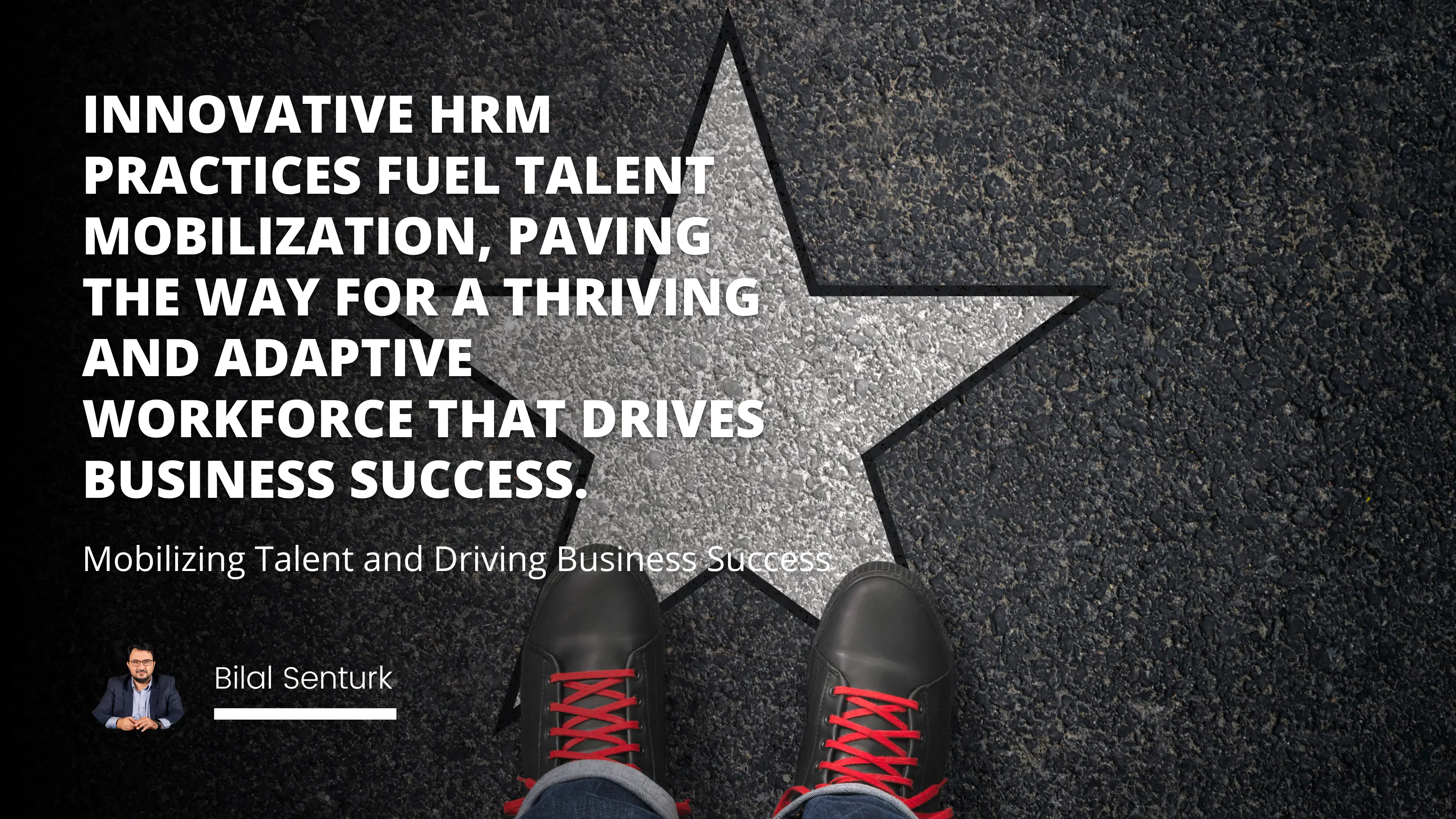
In the rapidly changing business landscape, innovative approaches in human resources management (HRM) are crucial to maintaining a competitive advantage and driving business success. The role of HRM has evolved beyond traditional administrative functions, such as recruiting, hiring, and payroll processing, into strategic business partner that plays a pivotal role in talent management, employee engagement, and organizational culture. This paper explores several innovative approaches in HRM, examining their benefits and challenges and how they contribute to mobilizing talent and driving business success.
Data-Driven HRM
Data-driven HRM, also known as HR analytics, involves the use of data and analytics to make informed decisions about human capital management. By leveraging data and advanced analytics tools, HR professionals can gain insights into employee performance, identify high-potential talent, and make better-informed decisions about hiring, promotions, and retention.
Benefits:
Improved decision-making based on evidence rather than intuition or subjective opinions.
Identification of talent gaps and areas for improvement in workforce planning.
A better understanding of the factors that contribute to employee engagement and productivity.
Challenges:
Ensuring data privacy and compliance with relevant regulations.
Developing the necessary analytical skills within the HR team.
Integrating data from various sources and systems to generate actionable insights.
Flexible Work Arrangements
Flexible work arrangements, such as remote work, flexible hours, and job-sharing, are becoming increasingly popular as organizations recognize the need for a better work-life balance for employees. This approach enables employees to have more control over their work schedules and environments, leading to higher engagement and job satisfaction.
Benefits:
Increased employee engagement and job satisfaction.
Attraction and retention of top talent.
Reduced overhead costs, such as office space and utilities.
Challenges:
Maintaining effective communication and collaboration among remote employees.
Ensuring consistent productivity and performance among employees working flexible hours.
Adapting organizational culture and management practices to support flexible work arrangements.
Employee Wellness Programs
Employee wellness programs focus on promoting employees' physical, mental, and emotional well-being through various initiatives, such as fitness programs, mental health support, and stress management workshops. By investing in employee wellness, organizations can create a healthier, more engaged, and productive workforce.
Related Course: Online Stress Management Course
Benefits:
Improved employee health and well-being, leading to reduced absenteeism and turnover.
Increased productivity and job satisfaction.
Enhanced employer brand and reputation as a desirable place to work.
Challenges:
Designing wellness programs that cater to diverse employee needs and preferences.
Measuring the return on investment (ROI) of wellness initiatives.
Encouraging employee participation and engagement in wellness programs.
Inclusive and Diverse Workplace Cultures
Creating an inclusive and diverse workplace culture involves valuing and respecting employees' unique backgrounds, perspectives, and experiences. By fostering a culture of inclusivity and diversity, organizations can unlock the potential of a diverse talent pool, drive innovation, and enhance overall business performance.
Benefits:
Enhanced creativity and innovation due to diverse perspectives and experiences.
Improved decision-making and problem-solving abilities.
Attraction and retention of top talent from diverse backgrounds.
Challenges:
Addressing unconscious bias and fostering a culture of inclusivity.
Ensuring fair and equitable opportunities for all employees.
Effectively managing and leveraging diversity within teams.
Continuous Learning and Development
In today's fast-paced business world, continuous learning and development are vital for employees to stay relevant and up-to-date with industry trends and skills. HR departments can play a crucial role in fostering a culture of continuous learning by offering training programs, mentoring opportunities, and access to online resources.
Benefits:
Enhanced employee skills and adaptability, contributing to improved job performance.
Increased employee engagement and motivation through personal and professional growth.
Attraction and retention of top talent seeking career development opportunities.
Challenges:
Identifying the most relevant and effective training and development programs for employees.
Ensuring that employees have the time and resources to participate in learning activities.
Measuring the ROI of training and development initiatives.
Implementing Agile HR Practices
Agile HR practices involve adopting flexible, iterative, and adaptive approaches to human resources management. This can include cross-functional teams, regular feedback loops, and decentralized decision-making processes. By embracing agility, HR departments can be more responsive to the changing needs of the organization and its employees.
Benefits:
Improved responsiveness to organizational and employee needs.
Enhanced collaboration and communication across teams and departments.
Faster and more efficient decision-making processes.
Challenges:
Adapting traditional HR processes and practices to agile methodologies.
Ensuring that agile HR practices are aligned with overall business objectives.
Overcoming resistance to change within the organization.
Leveraging Technology in HRM
Technology has the potential to transform HRM by automating routine tasks, streamlining processes, and enhancing communication and collaboration. Examples of technology-driven HR solutions include applicant tracking systems, performance management platforms, and virtual collaboration tools.
Benefits:
Increased efficiency and productivity through the automation of routine tasks.
Improved data accuracy and consistency, enabling better decision-making.
Enhanced employee experience through user-friendly platforms and tools.
Challenges:
Selecting the most suitable HR technology solutions for the organization.
Ensuring data privacy and security while adopting new technologies.
Training and supporting employees in the use of HR technology tools.
Employer Branding and Talent Attraction
Employer branding involves creating and promoting a positive and distinctive image of an organization as a desirable place to work. By developing a strong employer brand, organizations can attract and retain top talent, which is crucial for driving business success.
Benefits:
Attraction of high-quality candidates, leading to a more skilled and capable workforce.
Increased employee loyalty and retention, reducing the costs associated with turnover.
Enhanced overall reputation, which can have positive impacts on customer perceptions and business performance.
Challenges:
Developing and maintaining a consistent and authentic employer brand message.
Ensuring that the employer brand aligns with the organization's values and culture.
Effectively communicating the employer brand to both internal and external audiences.
Employee Voice and Empowerment
Encouraging employee voice and empowerment involves creating an environment where employees feel comfortable sharing their ideas, opinions, and concerns. By fostering open communication and actively seeking employee feedback, organizations can gain valuable insights into potential areas for improvement and enhance employee engagement.
Benefits:
Improved employee engagement and job satisfaction, leading to increased productivity.
Enhanced decision-making and problem-solving, as diverse perspectives are considered.
Increased sense of ownership and commitment among employees, driving positive change.
Challenges:
Creating a culture of trust and open communication where employees feel comfortable speaking up.
Implementing effective feedback mechanisms and ensuring that employee input is acted upon.
Balancing the need for employee empowerment with the need for management control and oversight.
Performance Management and Recognition
Modern performance management approaches focus on continuous feedback, goal alignment, and employee development, rather than solely on annual performance appraisals. By implementing effective performance management and recognition practices, organizations can motivate employees to achieve their full potential.
Benefits:
Increased employee motivation and engagement through regular feedback and recognition.
Improved alignment between individual and organizational goals, driving overall business success.
Enhanced employee development and growth, contributing to a more skilled and adaptable workforce.
Challenges:
Developing a fair and consistent performance management system that aligns with organizational objectives.
Training managers to provide effective and constructive feedback.
Ensuring that recognition practices are equitable and inclusive, rewarding employees based on merit.
By adopting these innovative approaches in human resources management, organizations can create a work environment that fosters employee engagement, well-being, and development, ultimately contributing to the organization's overall success. These practices, when implemented effectively, can result in a more agile, skilled, and motivated workforce that is better prepared to adapt to the challenges of the rapidly evolving business landscape.
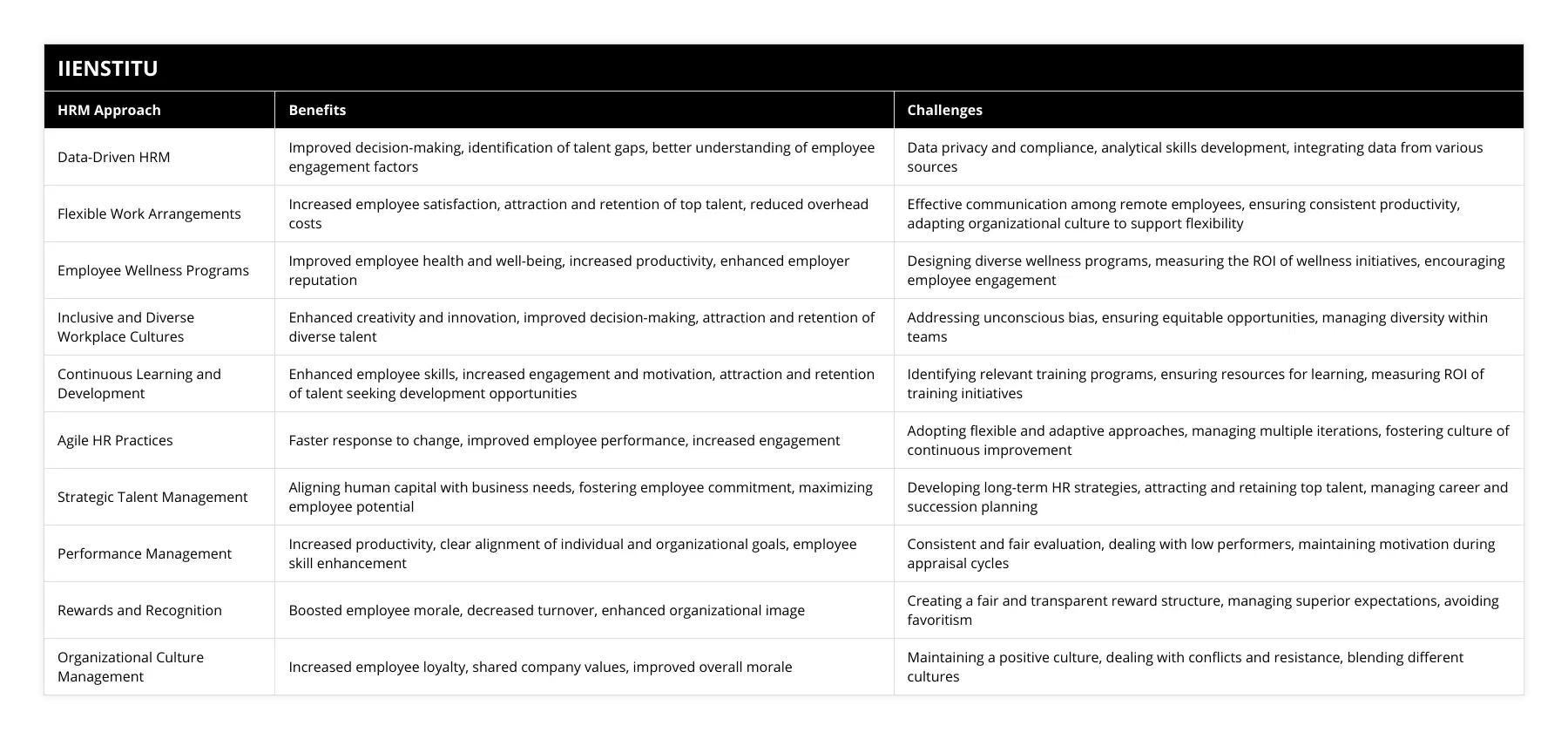
Frequently Asked Questions
What are the key factors that contribute to climate change?
Key Factors Contributing to Climate Change
There are several key factors that contribute significantly to climate change. The most significant is the burning of fossil fuels such as coal, oil and natural gas. When fossil fuels are burned, they release greenhouse gases like carbon dioxide and methane into the atmosphere. These greenhouse gases trap heat from the sun, causing global temperatures to rise.
Deforestation is another major factor. Trees absorb and store carbon dioxide. When forests are cleared, that stored carbon is released. Deforestation also reduces the number of trees available to remove carbon dioxide from the air. Between 2015 and 2020, the world lost over 4 million hectares of forest per year.
Intensive livestock farming generates significant greenhouse gas emissions. Cows and sheep produce methane as part of their digestive process. Large scale cattle ranching leads to deforestation too. The livestock sector accounts for around 15% of global emissions.
Other contributors are fertilizers containing nitrogen and the burning of biomass. Overall, human activities are responsible for almost all of the increase in greenhouse gases over the last century. To mitigate climate change, we must transition from fossil fuels to renewable energy and prevent further deforestation. We must also reduce emissions from agriculture and other sources.
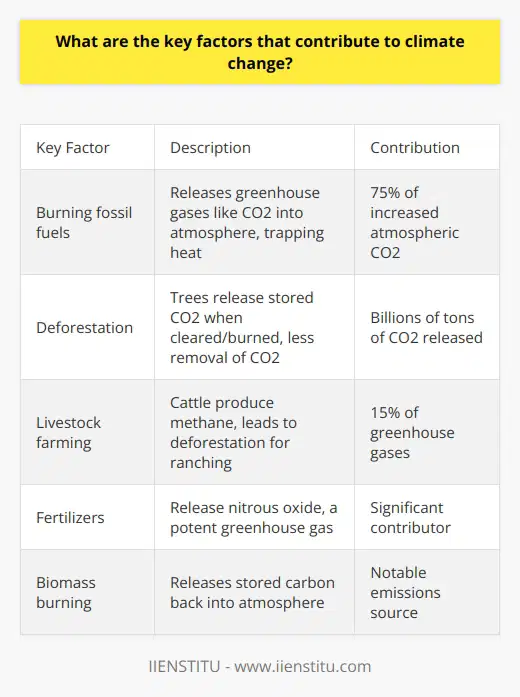
How does gender inequality manifest in different cultures?
Manifestations of Gender Inequality
Gender inequality refers to unequal treatment or perceptions of individuals based on their gender. This manifests in various ways across cultures. In many cultures, traditional gender roles cast women as caregivers and men as leaders. This leads to inequalities in domestic duties, employment, and positions of authority. For example, in parts of South Asia, women spend much more time on unpaid domestic work than men. In Saudi Arabia, strict laws prohibit women from traveling or working without a male guardian's permission.
Gender discrimination in education also perpetuates inequality. In Afghanistan, girls face barriers to attending school including lack of facilities, child marriage, and Taliban restrictions. Only 37% of Afghan girls complete primary education, compared to 66% of boys. This lack of education limits women's ability to participate in society.
Violence against women is another manifestation of gender inequality. Practices like female genital mutilation in parts of Africa, acid attacks in Southeast Asia, and honor killings in the Middle East target and control women. Up to 38% of murders of women worldwide are committed by intimate partners. Laws and enforcement often fail to protect women.
While many cultures have embedded gender inequalities, increased education for women and girls, activism, and legal protections are working to promote equal rights. Achieving gender equality requires changing long-held biases and practices.
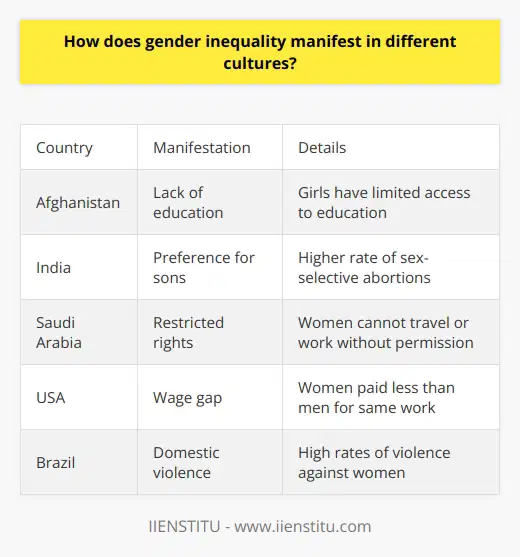
What policies can governments implement to reduce poverty?
Policies to Reduce Poverty
Governments can implement several policies to help reduce poverty. One important policy is to increase access to education. Governments can make primary and secondary education free and compulsory. They can also provide subsidies and scholarships to help low-income students attend college or vocational schools. Education gives people the skills needed to obtain better-paying jobs.
Another policy is to create more jobs and improve wages. Governments can invest in infrastructure and green technology to create construction and manufacturing jobs. They can set higher minimum wages and strengthen unions to improve pay. Policies that support small businesses can also lead to more job creation.
Governments can also strengthen social safety net programs. They can provide cash assistance, food stamps, and housing vouchers to help families meet their basic needs. Healthcare subsidies can make insurance more affordable. Increasing funding for childcare, disability, and unemployment benefits further aids those struggling financially.
Lastly, governments can reform tax policies to ease the burden on lower-income households. They can make tax systems more progressive by increasing taxes on the wealthy. Tax credits like the Earned Income Tax Credit can supplement wages for workers. Reducing regressive payroll and sales taxes helps increase take-home pay.
Implementing a mix of education, job creation, safety net, and tax reform policies can significantly reduce poverty. A comprehensive approach addresses both the symptoms and root causes of financial hardship for low-income families and individuals.

What are some examples of mobilizing talent and driving business success?
Mobilizing TalentTalent is the most important asset for any organization. Mobilizing talent involves attracting, developing, and retaining top performers to drive business success. Some examples of mobilizing talent include having strong recruitment and onboarding processes, providing training and development opportunities, offering competitive compensation and benefits, promoting work-life balance, and fostering an inclusive company culture.
Effective recruitment involves identifying talent needs, developing a recruitment strategy, leveraging online and offline channels, and having a strong employer brand. Strong onboarding gets new hires up to speed quickly through training, mentorship, and clear expectations. Ongoing training and development through workshops, conferences, job rotations, and tuition assistance helps employees continuously build skills. Competitive compensation and benefits like bonuses, healthcare, retirement plans, and perks attract and retain top talent. Work-life balance policies around remote work, leave, and flexible schedules help employees manage responsibilities. An inclusive culture values diversity and makes all employees feel welcomed and supported.
Driving Business SuccessMobilizing talent drives business success by having skilled, engaged, and empowered employees. Talented employees are more productive, provide better customer service, and are more innovative. Some examples of how mobilizing talent drives success include improved productivity, higher employee retention, increased innovation, and better customer satisfaction.
Productivity increases when employees have the right skills and tools to efficiently complete tasks. Retention improves when employees feel invested in and valued by the company. Innovation thrives when employees feel empowered to create and collaborate. Customer satisfaction rises when talented employees provide exceptional service and insights. Ultimately, mobilizing talent powers a workforce that can achieve strategic goals and drive better financial results.
In summary, mobilizing talent requires attracting, developing, and retaining top employees through strong recruitment, training, compensation, culture, and more. This builds a skilled, engaged workforce that drives business success through improved productivity, innovation, retention, and customer satisfaction. Organizations that tap into their people's potential gain a key competitive advantage.
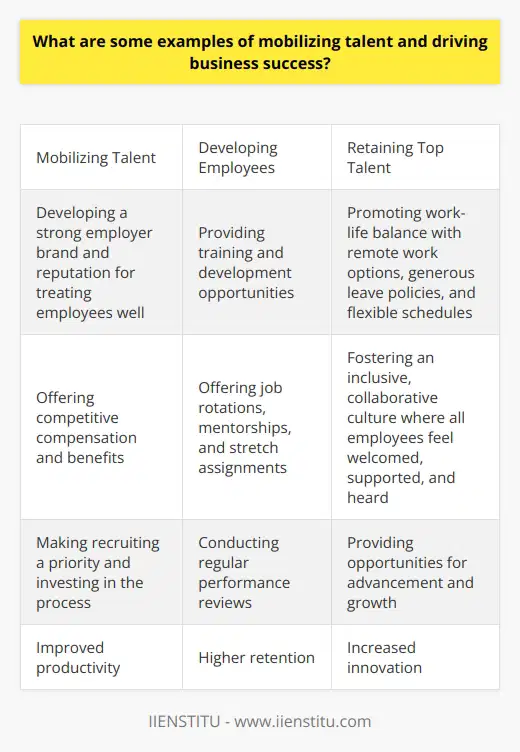
How can mobilizing talent and driving business success impact an organization?
Mobilizing TalentTalent is the most valuable asset of any organization. Mobilizing talent involves identifying, recruiting, developing, and retaining top talent. This allows an organization to build a skilled and motivated workforce. To mobilize talent, organizations must have strong talent acquisition and management strategies. They need to offer competitive compensation and benefits. Training, mentorship, and leadership development opportunities should be provided. By investing in employees and creating an engaging work culture, organizations can mobilize talent effectively.
Driving Business SuccessMobilized talent drives business success in several ways. Skilled employees are more productive and deliver higher quality work. They are able to identify opportunities for innovation and growth. Talented individuals can provide creative solutions to challenges. They bring strategic thinking and leadership capabilities. With strong talent, organizations can develop new products and services to meet customer needs. They can expand into new markets and geographies. Operational efficiency also improves through automation and process improvements. Ultimately, mobilized talent enables organizations to execute business strategies flawlessly.
Organizational ImpactWhen talent is mobilized effectively, organizations see positive impacts on culture, performance, and growth. Employees are engaged, empowered, and invested in the organization's success. Knowledge sharing and collaboration increase. Workplace culture becomes more inclusive and innovative. These factors boost productivity, efficiency, and profitability. With strong talent, organizations are able to adapt to changing markets. They gain competitive advantage through innovation. Shareholder value increases as financial performance improves. Organizations with mobilized talent attract top recruits. They are recognized as employers of choice. In essence, mobilizing talent and driving business success enables organizations to reach their full potential.

In what ways can leaders effectively mobilize talent and drive business success?
Mobilizing Talent for Business Success
Leaders can mobilize talent in their organizations through several key strategies. First, leaders should focus on hiring the right people and building strong teams. This involves identifying the skills and competencies needed for roles and seeking candidates that are a good culture fit. Onboarding and training help new hires develop necessary capabilities. Leaders must also encourage teamwork, collaboration and information sharing to fully leverage people’s talents.
Second, leaders can mobilize talent by empowering employees. This means pushing decision making down and giving people autonomy over their work. It also involves delegating important projects to tap into skills and passions. Empowered employees feel motivated to contribute their full talents. Leaders must provide support and resources for people to succeed in these empowered roles.
Third, leaders should connect talent strategy to business strategy. They must understand the organization’s goals and identify gaps in skills needed to achieve them. Training and development programs can then build talent capabilities for strategic priorities. Also, performance management and rewards can align to business objectives, motivating people to apply their talents accordingly.
Fourth, leaders must create an engaging culture that brings out the best in people. This means fostering open communication, collaboration and innovation. Employees need psychological safety to voice ideas and feel valued. Leaders should tailor management styles to individual needs. They must also role model desired behaviors and inspire the culture through clear and consistent messaging.
Finally, leaders should provide opportunities for growth. Employees want development and career advancement. Leaders should offer stretch assignments, new projects and lateral moves to expand experience. Internal mobility and succession planning help retain top talent. Mentorship programs and job rotations also build skills. By growing talent, leaders equip people to drive business success.
In summary, leaders can mobilize talent through hiring for fit, empowering people, linking talent to strategy, building an engaging culture, and enabling growth. This allows organizations to leverage their human capital for maximum business performance.
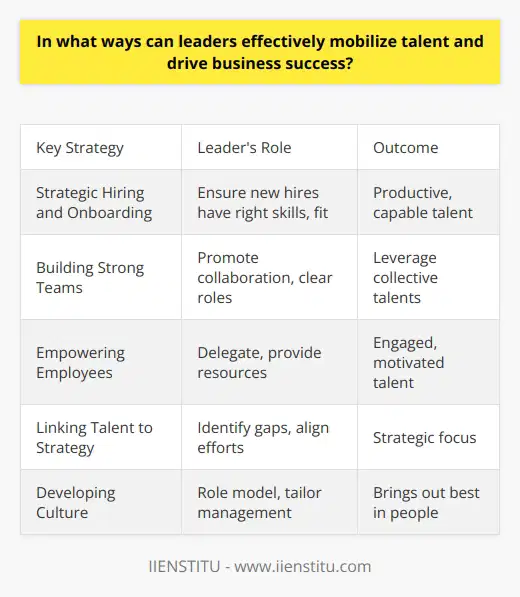
What strategies can be used for mobilizing talent and driving business success in 2021?
Strategies for Mobilizing Talent and Driving Business Success in 2021
In 2021, businesses need innovative strategies to mobilize talent and drive success in a rapidly changing environment. Some key strategies include leveraging technology, prioritizing diversity and inclusion, focusing on upskilling employees, and adopting flexible work arrangements.
Technology is crucial for connecting distributed workforces and providing tools for collaboration and productivity. Investing in digital platforms, automation, and data analytics helps businesses mobilize talent by removing geographical barriers and streamlining operations. Virtual collaboration tools like video conferencing and project management software also facilitate teamwork and innovation.
Embracing diversity and fostering inclusion are also essential for talent mobilization. Businesses should ensure diverse representation at all levels and create inclusive cultures where all employees feel valued and empowered to contribute. Mentorship and education programs can enhance inclusion. Diverse teams with broad perspectives drive innovation and growth.
Upskilling employees through training and development maximizes talent utilization. Assessing skill gaps and providing customized learning opportunities allows businesses to mobilize internal talent. Cross-training also boosts workforce agility. Educational assistance programs aid recruitment and retention.
Flexible arrangements like remote and hybrid work models further mobilize talent by expanding candidate pools and improving employee satisfaction. Accommodating individual needs and giving employees autonomy over when and where they work promotes engagement. Flexibility also aids diversity by removing location-based barriers.
In today's dynamic business landscape, mobilizing and optimizing talent is critical for success. Leveraging technology, prioritizing diversity, upskilling employees, and offering flexibility represent effective strategies for businesses to drive growth, innovation, and value in 2021 and beyond.
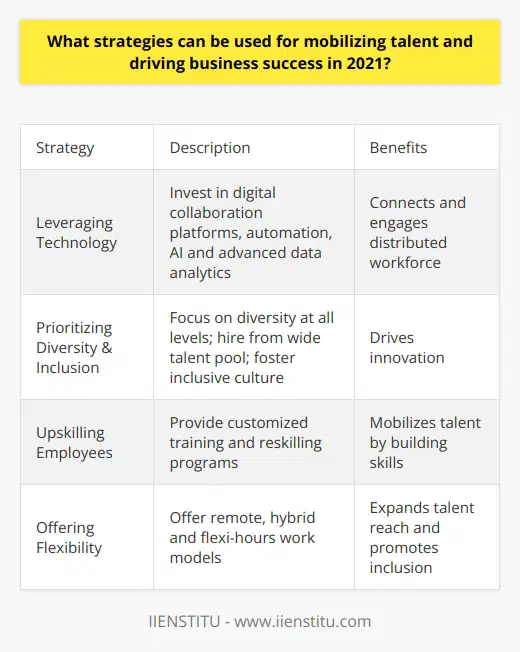
How can organizations effectively mobilize talent to drive business success and growth in the coming year?
Developing and Retaining Top TalentIn order to drive business success and growth, organizations need to focus on developing and retaining top talent. This starts with having a strong recruitment process to identify and hire the best people. Organizations should invest in training and development programs to help employees build new skills. Coaching and mentoring can also be beneficial. Competitive compensation and benefits help retain top performers. Promoting from within and offering clear career paths are effective retention strategies. Organizations that support work-life balance through flexible schedules tend to have more engaged employees. Celebrating successes and providing recognition for achievements also boosts morale and retention.
Fostering Innovation and Collaboration Organizations need to create a culture that encourages innovation and collaboration. This means providing opportunities for employees to share ideas and work creatively in teams. Brainstorming sessions, hackathons and design thinking workshops can stimulate new ideas. Providing time and resources for employees to experiment with new concepts shows that innovation is valued. When people feel psychologically safe to take risks, they are more likely to think outside the box. An open office layout and shared spaces can facilitate collaboration. Leaders should solicit input from all levels of the organization. Diversity of perspectives leads to better ideas and solutions.
Leveraging TechnologyAdvances in technology provide new opportunities for organizations to mobilize talent. Artificial intelligence and data analytics enable more efficient operations and informed decision making. Automation of repetitive tasks gives employees more time for strategic work. Collaboration tools like videoconferencing and cloud-based document sharing foster teamwork. Social media platforms allow organizations to identify and recruit skilled candidates. Learning management systems make training more accessible and effective. Organizations that embrace technology and equip employees with the latest tools position themselves for success. Proper change management and training help employees adapt to new technologies.
Empowering EmployeesOrganizations must empower employees at all levels to fully mobilize talent. Leaders should communicate a clear vision and strategy then give people autonomy to determine how to best do their work. Managers should coach employees and provide constructive feedback to help them develop. Employees should have access to the resources and information needed to make decisions. Organizations can tap into the collective wisdom of employees by crowdsourcing ideas. Surveys provide insight into engagement levels across the company. When employees feel trusted and valued, they become highly motivated. This empowers them to take initiative and responsibility.
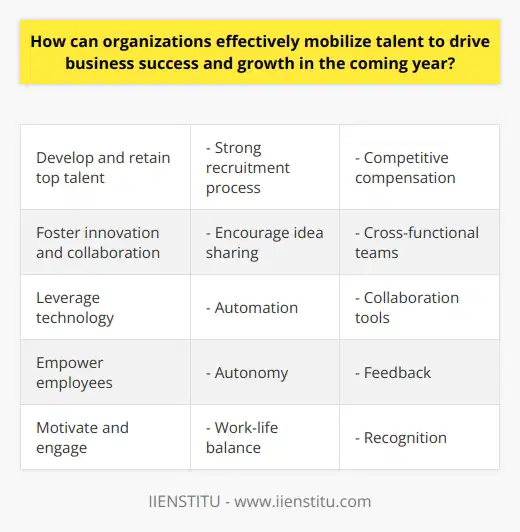
What best practices should be adopted in 2021 for mobilizing talent and achieving greater business success?
Best Practices for Mobilizing Talent and Achieving Business Success in 2021
Companies should focus on improving their talent strategies and leadership capabilities in 2021 to drive greater business success. Adopting best practices around hiring, developing, and retaining top talent while also enhancing leadership skills will mobilize human capital and lead to positive outcomes.
Hiring the right people is crucial. Organizations should prioritize diversity and inclusion when recruiting to get access to the widest talent pool. They should also emphasize skills over credentials and degrees, looking for candidates with growth mindsets who are eager to learn on the job. Using standardized and structured interviews helps remove bias from the hiring process.
Once companies have the right talent, they must invest in developing people. Leaders should act as talent coaches through regular feedback, mentoring, and stretch assignments. Companies should provide access to learning opportunities like online courses or tuition assistance. Rotational programs give employees exposure to various roles.
Retaining and engaging talent is equally important. Flexible work policies, career development paths, and fair compensation incentivize people to stay. Fostering an inclusive, ethical culture makes employees feel valued. Small gestures like recognition programs go a long way as well.
Developing strong leadership is vital too. Companies should identify high-potential managers and support them with leadership training. Programs that enhance emotional intelligence, communication, and strategic thinking prepare managers for greater responsibilities. Mentoring relationships between new and experienced leaders also boost skills.
Implementing these best practices for hiring, developing, and retaining top talent while cultivating strong leadership will lead to a more engaged, empowered workforce. With the right human capital strategies, companies position themselves for innovation, productivity, and business success in 2021 and beyond.
